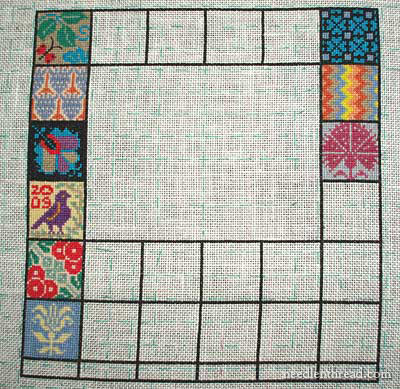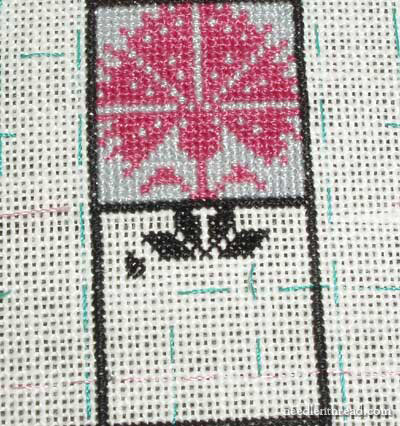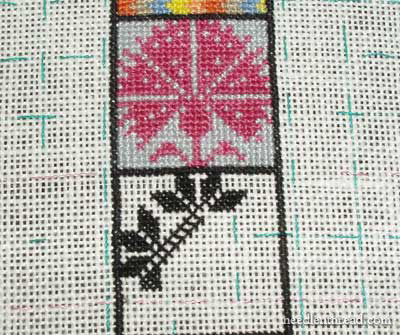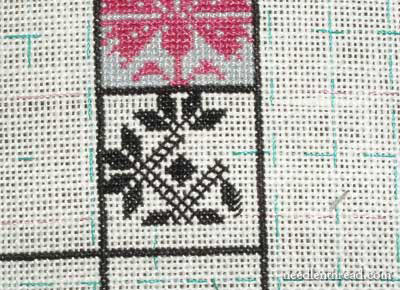Do you work outside your home? I do. Between the middle of August and the end of May, my real job actually takes precedent over my needlework! (Can you believe I allow that??!) Now, this isn’t just because the real job pays the bills – it’s also because, if it is to be done well, the job demands it, and I love my job! I like teaching a lot, even though, yes, it does occasionally have its Moments. Needlework, during the school year, becomes my carrot – the thing that motivates me to do what I need to do, work-wise, so that I can enjoy relaxing with my needle and thread. And, as you avid stitchers know, needlework can also serve as a tremendous stress reliever!
But, when the work week is hectic, it’s often difficult to find time to squeeze in a needlework project. Often, what ends up happening is that, because no progress is being made at all on the project, it gets side-lined, interest in it gradually wanes, it is finally stowed away, and… The End.
To avoid this, I started “forcing” myself (ok! right! it doesn’t take that much force!) to fit in at least 15 minutes a day stitching. Whether those 15 minutes are snatched on a lunch break or between classes, whether they are found at the very end of the day before hitting the sack, or whether they are squeezed in first thing in the morning, before heading out to work (assuming I’m ahead of schedule!) – whatever the case may be, those 15 minutes serve three useful purposes: 1. they provide a momentary “break” doing something I really love; 2. they keep my projects going at least a wee bit and I feel as if I’m making progress; and 3. I don’t have that overwhelming feeling of “needing to start,” which can make me lose interest in a particular project and relegate it to the shelf.
That’s the background of my 15-minute sessions. And here are some results from a few sessions last week.
On a few days, I only barely managed 15 minutes! Other days, I had more time in the evenings, and could make more progress than shown below. But for now, here are three 15 minute sessions that were snatched during the week:

I had two projects out this week – my Schwalm whitework project and this Long Dog Sampler. I started this sampler last spring. My niece wanted to work a counted cross stitch piece since they were covering the technique in home ec, and she really liked this Long Dog sampler called “Angel Pavement.” So I purchased two copies, one for her, one for me, and we went thread and fabric shopping, and settled on working the sampler on 28 ct fabric over one thread. She’s still plugging away on hers, though she works more sporadically all over the place on the chart than I do!
I haven’t made any progress on this since I put it away last spring, but it’s out again now, because it is perfect for 15 minute sessions.

In the first 15 minute session, I didn’t get very far at all! You would almost be tempted to say, “This is not progress!” But the way I see it is, any stitch is progress! During that first session, I had to dig for thread, cut it, strip it, and thread two needles (which was wishful thinking – I didn’t even use one full-threaded needle).

In the next 15 minute session, I stuck the frame on my Needlework System 4 stand, rather than holding it, and I resorted to two-handed stitching, which is a lot faster than one-handed!

And, by the third 15 minute session, I was making good headway. When I ended the previous session, I threaded a new piece of floss and had it ready for beginning, and, with both hands stitching, it went fairly well.
Now, keep in mind this little piece is not quite an inch square – so, in the scheme of things, it doesn’t look like much stitching! But really – it is progress! And, as I mentioned before, this really serves as a motivator! I find myself seeking the next 15 minutes, just to see how far I can get in the next session. And, better yet, I find myself getting other things done that I need to get done, with more efficiency, so that I can squeeze in 15 minutes.
Do you use needlework as a carrot? Do you try to carve out bits of your day that you can devote to it? How do you go about doing so? Does it help motivate you in your other daily tasks? I’d love to hear how you deal with limited time and needlework!







I hadn't really thought of using 15 minutes a day. I've been a bit stressed about when I will have time to work on my project since I am at my desk a full 10 hours a day. Someone has to be in the office to answer phones and I'm usually the only one in there!
Looking at your post I found myself thinking about pulling out my project to show "Sorry, out to lunch." Thanks, I can now see the project getting finished in time!
Ren
I used always do a little something – my mom knits so I followed her example, especially when I needed a gift or felt the urge. I recently became disabled and was at a lose at what to do with all the time I suddenly found I had. So I decided to give embroidery a try. Needlework isn't a carrot to me, rather it protects my sanity and I have found new friends over the internet and where I live because of it. Finding you has been a godsend! I feel like I have accomplished something at the end of the day, even if it is the next box of the long and short lessons. Thank you so much.
I've been trying to follow a 15 minutes a day plan, with reasonable success. I particularly value a stitch session before I leave for work, it sets me up for the day.
I'm finding this easier with my current bead project than with the silk embroidery. If I only manage 15 mins, it doesn't seem to get me very far, but by the end of the week it is surprising how much I have got done.
For me it's not so much a carrot as it is claiming a little bit of time for myself and something I want to do, when the rest of the day will most likely be given to things I have to do, mostly for other peps!
Needlework is my carrot on days when I am busy with the boring tedium of life…running errands, cleaning, etc. I can`t wait to get finished my chores so I can sit down with my threaded needle. I find myself solving little needlework problems while i`m working…mulling over colours while vacuuming…second guessing fabric choices while up to my elbows in dishes. I am my elderly mom`s caregiver, so I have a fair amount of flexability in my day.Time spent stitching is soothing, and gives me a feeling I am accomplishing something for myself.If I am too tired to stitch at the end of the day, I either plan a new project or read needlework books and magazines. Thank god for my needle and thread!
Needlework (and other hand work…) are my sanity tools. Since my husband and I have just one car, and he starts an hour before I do, I try to always have a portable project which I can work on after I've dropped him off and get to my office. In the evenings if we're "just" watching TV, I'm working on something as well (though sometimes that is research for the next project….)
15 minutes each? I'd say you're working at a nice clip, particularly at 28 count over 1!
Balance. I am trying to find that balance to work (being a teacher) and my needlecrafts hobbies. I am getting better and better at it! It takes discipline to do it though. Right now I am on sick leave so I am hoping to get more accomplished ;).
Good post!
Believe me, 15 minutes a day would eventually get me somewhere but still not nearly as quickly as you are working through that project! Call me Slow.
Mary, I recently finished a pastel version of your Easter Bread Cloth. It took weeks. not A week like yours did.
Mary, I think you found a great way to keep everything going in your life. Since this is not the first time you write about your 15 minutes technique, I've been trying to apply that to my own routing – only to find out that planning is the key to make it work! Now I've planned to sew a few bags for my works in progress, so they will be organized for any 15 minutes I get. I think it'll work fine, and I obviously already have a few works in bags ready to use (long and short stitch lessons are on their way!).
One question for you: what's two-handed stitching and how does that work? You probably have already talked about it here, so I'll search later – the boss might not enjoy needles and threads as much as we do! 😉
Hi, all – thanks for your comments! I'm glad that you, too, are finding a way to fit at least 15 minutes into your day! It's not always easy, eh?! But it's a good way to make progress!
Samanta – I don't know if I have actually written much about two-handed stitching, except in passing. Basically, to stitch two-handed, you need to have your work on some kind of stand, so that you don't have to use a hand to hold it. Sometimes, I can sit at a table, rest the frame on the edge of the table and on my lap – or against my torso – and not use a stand. What you do is keep your dominant hand underneath your work to receive the needle and push it to the front. With your less dominant hand, you work on the top, pushing the needle back to the back. At first, it takes some real getting used to, and it is slow. If you are right-handed, for example, your left hand is on top of your work, and you have to train it to place the needle accurately. The technique works quite well, especially for counted work (though it works equally as well for goldwork, needlepainting, etc.). I find that I can work almost twice as fast, using two hands, and using shorter lengths of thread. While the shorter lengths may require starting and ending threads more often, if you pre-thread your needles, this speeds up the changing process. With shorter lengths of thread, it doesn't take as long to make a stitch, because you aren't having to pull the thread through as far.
Anyway, perhaps I'll write up a more detailed post on this! It would be somewhat difficult to demonstrate with photos, but maybe I can manage something!
Thanks again for your comments!
MC
Like some of the others, stitching isn't so much a carrot for me, as a sanity enhancer!
I consider stitching to be my daily "therapy", a stress release at the end of the day, and a fantastic was to get my day off to a good start.
Each morning I deliberately get up half an hour earlier than I really need to, and I make sure I spend half an hour stitching before I leave for work.
Then each evening I stitch while "watching" tv – my DH watches, I listen, LOL.
I find the rhythm of stitching to be a wonderful way to relax.
Jocelyn
I've been wondering about the blue lines 'basted' on your work – what are they for? I'm not sure if basted is the correct word, but I'm more familiar with sewing terms and that means a long stitch! 🙂
I've really been enjoying your blog and learning so much – thank you.
Hi, Karen –
I call them basted, too.
Because the pattern for this project is spread over 6 separate pages, and because it's the kind of design that I will hop around on a bit, with lots of little elements, I marked off the fabric to match the dark lines on the graph, every ten threads. That way, I don't really have to count threads – I just locate the square the design element is in, and at a glance, I can see where to start a particular part of the design.
Basting this many lines into the fabric before starting the project was time consuming. If I were to do it again, I might go every 20 threads with a basted line. But it has made the placement part of the stitching Very Easy – I've had no worries about being a stitch off or anything like that. And so, in the long run, the extra effort at the beginning of the project has paid off.
Basting in extra guide lines is not a required step – most people probably just baste in their center lines and count from there. Still, like I said, in the long run, it's worked well for me!
Hope that helps.
MC
Thank you – good idea, I'll remember it!
Hi, I'm a student just beginning college this year. The program I am in is especially demanding, this year with architectural design studio and more to the math and engineering side in the next few years. I was taught basic embroidery when I was seven-ish and since then I've kind of taught myself various crafts. Usually a person will inspire any given project for me.. like my recent ambitious Star Wars and IB Physics themed baby quilt for a teacher.. That project I spent a good 8 1/2 months, several hours a day many days. It was a freak circumstance for me because I had a deadline of the baby being born/Graduation, hehe! Usually my projects get shoved to the side until a vacation (we're big travelers, and man it was a sad day when terrorist attacks prevented a little girl from bringing her knitting needles on the plane when before that it was allowed every time! but hey apparently plastic and bamboo were allowed)
Perhaps I will try to do this 15 (maybe 20, I'm really slow!) minute approach when I'm at school. I literally have a sheet of printer paper gridded out for every half hour each day that I block out with my schedule and planned study time.. otherwise things like eating lunch just don't happen and that can't be healthy. lol. I find that a lot of my time is wasted thinking about everything I should be doing at the moment instead of actually doing things!
So since quilting in a dorm room is out of the question due to space and budget, I'm thinking I want to take a stab at my stockpile of samplers (maybe eventually the 12×18 one of the Titanic on 18 count aida).
I happened upon the concept of "gridding" just the other night when I was looking at some tips to cross stitch faster, make less mistakes etc. I can't figure out how exactly I'm supposed to do the gridding, though. For example, at first I was thinking OKAY now I take a really long single thread and do a running stitch every 5 stitches vertically.. then do that every 10 columns. or I could make squares 10 wide..same idea. But how do I get the thread out afterward? Is there a type of floss that is monofilament (like fishing line) so the needle won't poke through it? or is a better approach to remove the grid as you stitch the design… but will that come loose if you cut out parts and leave a bunch of loose floss to get in the way?
Thanks,
Lexi
Hi, Lexi –
Yes, the 15 minute approach is sometimes the only way to get any stitching in, when life is hectic!
For "gridding" – which works well for especially complex patterns – you determine how many threads you want to count off, and then you work running stitches in a contrasting color of regular sewing thread along your grid. Then, as you stitch, you cut the running stitches around the area where you're working, once you've already determined where to start in that area, and you pull out the running stitches just in that area as you're getting near to stitching over them. You don't want to stitch over them – it's best just to clip them as you come close to them.
I gridded 10×10 on this one, and even though it was a major pain in the neck to do it, in the end I was glad. It has made stitching this so simple.
Well, take it easy, Lexi, and best of luck in school!
MC
Thank you for responding! I think I understand what to do now. I just finished all but the letters on the project I'm working on at the moment. It was really simple, an IOU for a white elephant gift. Funny how this is probably the most meaningful gift, but the last one chosen because it was just a piece of paper. 😛 and this one http://www.willowfabrics.com/acatalog/jasper_with_rose.jpg I think is next on my to-do list. I have all the black and most of the dark gray done. Maybe doing one color at a time isn't the best method, but that's what I have done in the past. Hopefully I'll be able my project-ADD under control until that one is finished.
Merry Christmas to you!
– Lexi